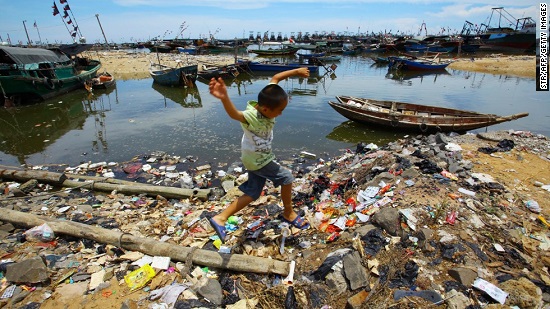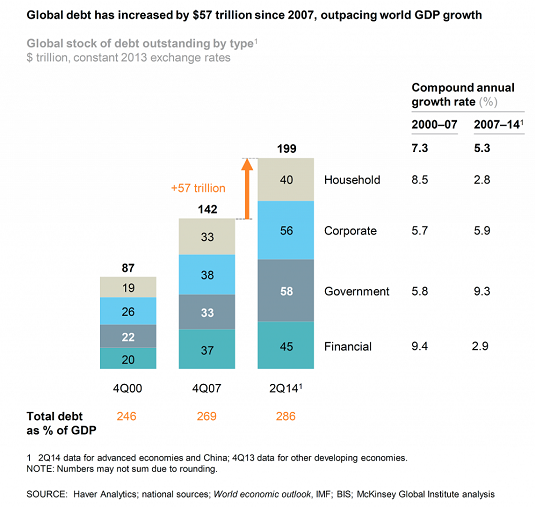How Do We Design a DeGrowth Economy?
I’ve written about DeGrowth for many years, including Degrowth, Anti-Consumerism and Peak Consumption (May 9, 2013), Degrowth Solutions: Half-Farmer, Half-X (July 19, 2014) and And the Next Big Thing Is … Degrowth? (April 7, 2014)
These are the basic concepts of Degrowth:
1. Consumerism is psychological/ spiritual junk food (French: malbouffe) that actively reduces well-being (bien-etre) rather than increases it.
2. Better rather than more: well-being is increased by everything that cannot be commoditized by a market economy or financialized by a cartel-state financial machine– friendship, family, community, self-cultivation. The goal of economic and social growth should be better, not more. On a national scale, the cancerous-growth measured by gross domestic product (GDP) should be replaced with gross domestic happiness/ gross national happiness (GNH).
3. A recognition that resources are not infinite, despite claims to the contrary. For one example of many: China Is Plundering the Planet’s Seas (The Atlantic). Indeed, all the evidence suggests that access to cheap energy only speeds up the depletion and despoliation of every other resource.
4. The unsustainability of consumerist “growth” that’s dependent on resource depletion funded by financialization (i.e. the endless expansion of credit and phantom collateral). (This is covered in greater depth in my short book Why Our Status Quo Failed and Is Beyond Reform.)
5. The diminishing returns on private consumption and “bridges to nowhere” (crony-capitalist public consumption).
6. The failure of neoliberal capitalism and communism alike in their pursuit of growth at any cost.
Degrowth is heresy in what John Michael Greer calls the religion of progress (i.e. growth).
The faith that growth equals progress is akin to the Cargo Cult of Keynesianism, the notion that expanding debt exponentially to drive diminishing returns of growth is not only necessary but a moral imperative.
Both the religion of growth and its Cargo Cult are narratives used to justify the expansion of global finance via financialization. Expanding capital, profits and power is the key driver, and the religion of growth is merely the public-relations narrative that mesmerizes the debt-serfs, political toadies and media sycophants.
Does this look like a world with plenty of room for everything to expand?

Does this look like a world ripe for limitless expansion of debt to fuel limitless growth of consumption?

This leads to a fundamental question: how do we design a system that enables us to do more with less of everything? How do we design a system that incentivizes doing more with less rather than squandering resources via optimizing human greed?
A DeGrowth economy must fulfill two requirements:
1. The DeGrowth economy must provide paid-work livelihoods and opportunities for everyone who wants them.
2. The DeGrowth economy must institutionalize a decentralized, democratic, self-organizing process to allocate human, social, resource and financial capital as an alternative to centralized states/banks and profit-maximizing corporations.
These arise from three key insights:
1. If we don’t change the way we create and distribute money, we change nothing.
2. Not everything that is valuable is profitable, and so maximizing profit is not the sole arbiter of “value,” nor is it a sound process for allocating labor and capital for everything that has value but isn’t profitable.
3. Centralization undermines democracy and generates privilege, inequality, insecurity, conflict and waste by its very nature. (I discuss this further in my short book Inequality and the Collapse of Privilege.)
DeGrowth requires two intertwined systems: a decentralized, localized, globally connected network of self-organizing productive “tribes” whose labor generates a global labor-backed crypto-currency.
I describe such a system in my book A Radically Beneficial World: Automation, Technology & Creating Jobs for All.
DeGrowth is coming whether we like it or not or plan for it or not. Our choice is to blind ourselves to the implosion of the “growth” status quo and squander the opportunity to create an economic system that thrives in DeGrowth, or accept the end-game of financialized “growth” and embrace the technological tools that enable decentralized, localized, globally connected networks funded by a labor-backed crypto-currency.
The conventional objections to DeGrowth boil down to: it isn’t the status quo, so it can’t possibly work. Actually, it’s the status quo that isn’t working, and DeGrowth is the result of that simple yet profound reality.
For more on these topics:
If We Don’t Change the Way Money Is Created and Distributed, Rising Inequality Will Trigger Social Disorder (November 13, 2015)
A Radically Beneficial World: Automation, Technology and Creating Jobs for All (free 35-page excerpt)
If you found value in this content, please join me in seeking solutions by becoming a $1/month patron of my work via patreon.com.
Leave a Reply